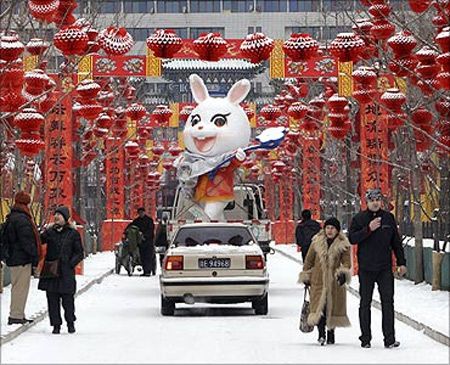 In a major sign of transformation of manufacturing-dominated Chinese economy, annual output of its service sector may exceed that of the manufacturing sector for the first time ever in 2013, an expert said.
In a major sign of transformation of manufacturing-dominated Chinese economy, annual output of its service sector may exceed that of the manufacturing sector for the first time ever in 2013, an expert said.
In the first nine months of the year, value-added output of the service sector reached 17.6 trillion yuan ($1.17 trillion) slightly more than 17.51 trillion yuan for manufacturing, data from the National Bureau of Statistics (NBS) showed.
The service sector's annual output may top that of secondary industry, or manufacturing, in 2013 for the first time, marking a historic change in the country's economic restructuring, Zhang Zhigang, head of the China General Chamber of Commerce, said at a forum.
China, widely regarded as the factory of the world, was heavily dependent on manufacturing so long by becoming the world's largest exporter.
Zhang lauded China's policies to replace turnover tax with value-added tax (VAT) within the service sector in order to reduce double taxation and alleviate the burden of affected companies.
"The move is very helpful for promoting the growth of the service sector, and the effects of policy will further emerge after implementation," he said, adding that VAT reform may reduce the tax burden by 120 billion yuan this year.
Following regional experiments since the beginning of 2012, VAT reform was rolled out throughout the country on August 1, reducing taxes on businesses by 94 billion yuan in the first 10 months of this year.
"It is a common trend of industrial transformation in developed nations for the service sector to become the largest in the national economy," Zhang was quoted by the state-run Xinhua news agency as saying.
Today's figures showed inflation in China easing in November. Analysts believe slower rising prices coupled with slightly improving growth prospects should positively influence markets and policymakers.
The NBS also said the consumer price index (CPI), a main gauge of inflation, grew 3 per cent year-on-year in November, down from 3.2 per cent in October. Inflation was 3 per cent in cities and 3.1 per cent in rural areas.
Food prices rose 5.9 per cent in the last year, while non-food products edged up only 1.6 per cent. In the first 11 months of 2013, CPI rose 2.6 per cent year-on-year, well below the government target for the year of 3.5 per cent, another Xinhua report said.
Yu Qiumei, a senior statistician with the NBS, said food prices, which account for roughly a third of CPI, edged down slightly in November. Grain, beef, mutton, milk and fruit all rose month-on-month but pork, fresh vegetables, eggs and aquatic products were all down.
November's vegetable prices contracted by 3.8 per cent from October, but Yu stressed differences in vegetable prices across regions. In the northeast and northwest vegetable prices rise due to snow and low temperatures, while vegetable prices fell in most other parts of the country.
The moderation in CPI was due to lower food inflation, according to a research note by Zhi Xiaojia and Lu Ting of Bank of America Merrill Lynch.







 © 2025
© 2025